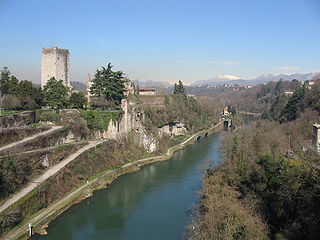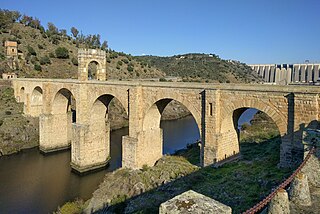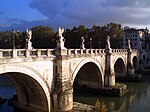
The Ponte Vecchio is a medieval stone closed-spandrel segmental arch bridge over the Arno River, in Florence, Italy. It is noted for the shops built along it; building shops on such bridges was once a common practice. Butchers, tanners, and farmers initially occupied the shops; the present tenants are jewelers, art dealers, and souvenir sellers. The Ponte Vecchio's two neighboring bridges are the Ponte Santa Trinita and the Ponte alle Grazie.

An arch is a vertical curved structure that spans an elevated space and may or may not support the weight above it, or in case of a horizontal arch like an arch dam, the hydrostatic pressure against it.

The ancient Romans were the first civilization to build large, permanent bridges. Early Roman bridges used techniques introduced by Etruscan immigrants, but the Romans improved those skills, developing and enhancing methods such as arches and keystones. There were three major types of Roman bridge: wooden, pontoon, and stone. Early Roman bridges were wooden, but by the 2nd century stone was being used. Stone bridges used the arch as their basic structure, and most used concrete, the first use of this material in bridge-building.

An arch bridge is a bridge with abutments at each end shaped as a curved arch. Arch bridges work by transferring the weight of the bridge and its loads partially into a horizontal thrust restrained by the abutments at either side. A viaduct may be made from a series of arches, although other more economical structures are typically used today.

The Anji Bridge is the world's oldest open-spandrel segmental arch bridge of stone construction. Credited to the design of a craftsman named Li Chun, the bridge was constructed in the years 595–605 during the Sui dynasty (581–618). Located in the southern part of Hebei Province, it is the oldest standing bridge in China. It is considered one of the Four Treasures of Hebei.

The Bacchiglione is a river that flows in Veneto, northern Italy. It rises in the Alps and empties about 90 miles (140 km) later into the Brenta River near Chioggia. It flows through and past a number of cities, including Vicenza and Padua. It acted for many centuries as a significant waterway up to Vicenza, above which it ceases to be navigable. It was connected in the 19th century to the Adige by a canal.

The Ponte Pietra, is a Roman arch bridge crossing the Adige River in Verona, Italy. The bridge was completed in 100 BC, and the Via Postumia from Genoa to Aquileia passed over it. It is the oldest bridge in Verona.

The Alconétar Bridge, also known as Puente de Mantible, was a Roman segmental arch bridge in the Extremadura region, Spain. The ancient structure, which featured flattened arches with a span-to-rise ratio of 4–5:1, is one of the earliest of its kind. Due to its design, it is assumed that the bridge was erected in the early 2nd century AD by the emperors Trajan or Hadrian, possibly under the guidance of Apollodorus of Damascus, the most famous architect of the time.

The Trezzo sull'Adda Bridge or Trezzo Bridge was a medieval bridge at Trezzo sull'Adda in Lombardy, Italy, spanning the Adda river. Completed in 1377, the single-arch bridge held the record for the largest span for over four hundred years, until the beginnings of the Industrial Age, while it was not until the early 20th century that masonry bridges with larger openings were constructed.

The Alcántara Bridge is a Roman bridge at Alcántara, in Extremadura, Spain. Alcántara is from the Arabic word al-Qantarah (القنطرة) meaning "the arch". The stone arch bridge was built over the Tagus River between 104 and 106 AD by an order of the Roman emperor Trajan in 98.
The Ponte San Lorenzo is a Roman bridge over the river Bacchiglione in Padua, Italy. Constructed between 47 and 30 BC, it is one of the very earliest segmental arched bridges in the world. It is also notable for the slenderness of its piers, unsurpassed in antiquity.

The Ponte Nomentano is a Roman bridge in Rome, Italy, which carried the Via Nomentana over the Aniene. Having lain outside the city limits for most of its history, the picturesque bridge is noted for its medieval bridge tower, which served to protect this important northern approach to Rome.

The Ponte Salario, also called Ponte Salaro during the Middle Ages, is a road bridge in Rome, Italy, whose origins date back to the Roman period. In antiquity, it lay outside the city limits, 3 km north of the Porta Collina, at the point where the Via Salaria crossed the Aniene, a tributary of the Tiber. The visible side arches are assumed to originate from the first stone structure built during the 1st century BC.
The Ponte Altinate is a Roman bridge in Padua, Italy. The late Republican bridge once spanned a branch of the Brenta river whose course is today followed by the street Riviera del Ponti Romani. The structure is located at the crossing with Via Altinate and, lying underground, completely obstructed from view by the modern pavement.

The Ponte Molino is a Roman bridge across the Bacchiglione in Padua, Italy. The span-to-rise ratio of the Late Republican bridge varies between 3.5–4.5 and 1, the ratio of clear span and pier thickness between 4–6.5 and 1.

The Bridge of Cava da Velha is a Roman bridge, situated in the civil parish of Castro Laboreiro e Lamas de Mouro, in the municipality of Melgaço in northern Portuguese district of Viana do Castelo.
The Susegana Bridge is one of a series of Roman bridges on the Via Claudia Augusta in Susegana, northern Italy. The small structure is notable for its flattened arch, which classify it as a Roman segmental arch bridge.
The Rhodes Footbridge is an ancient Greek arch bridge in the city of Rhodes, Greece. Dating to the 4th century BC or early Hellenistic period, the modest structure represents the oldest known Greek bridge with a voussoir arch.














